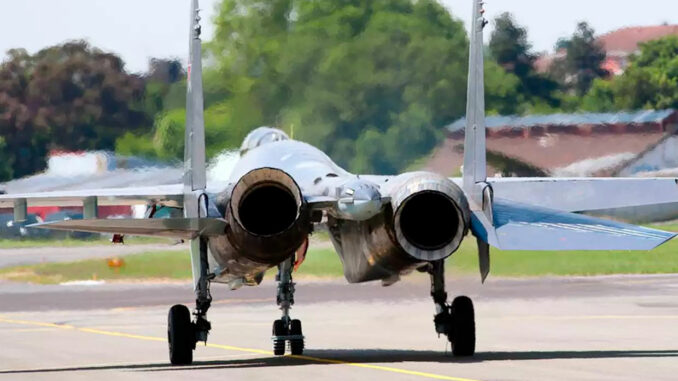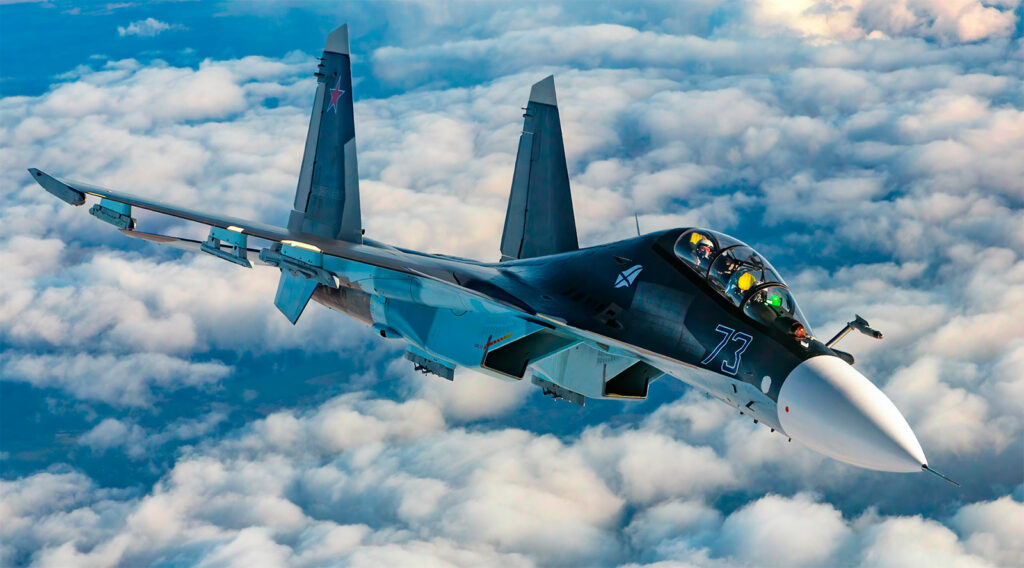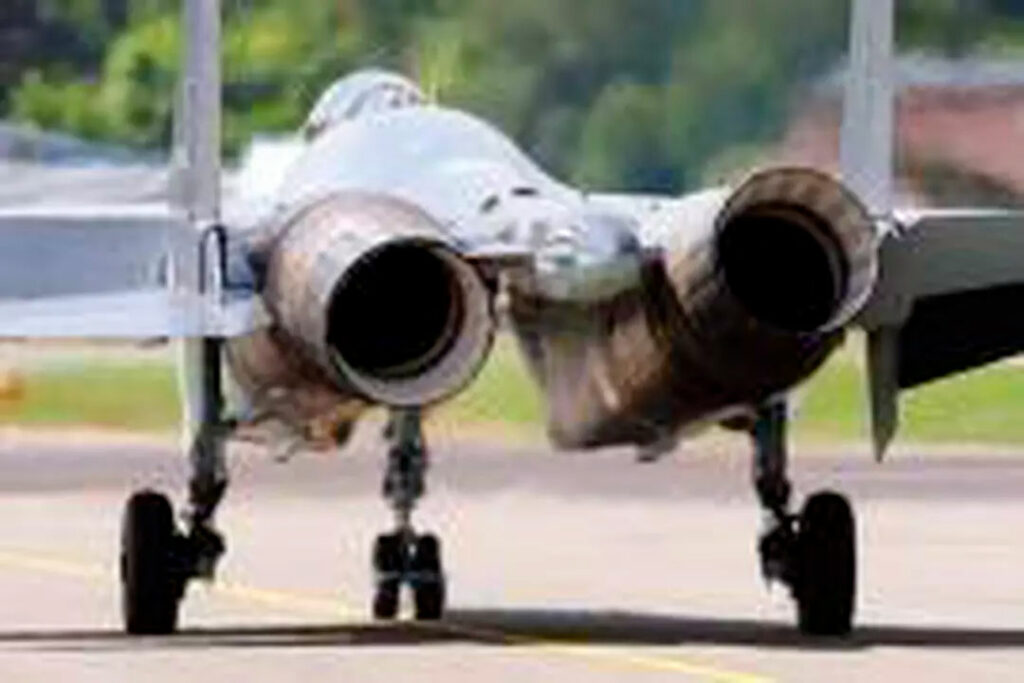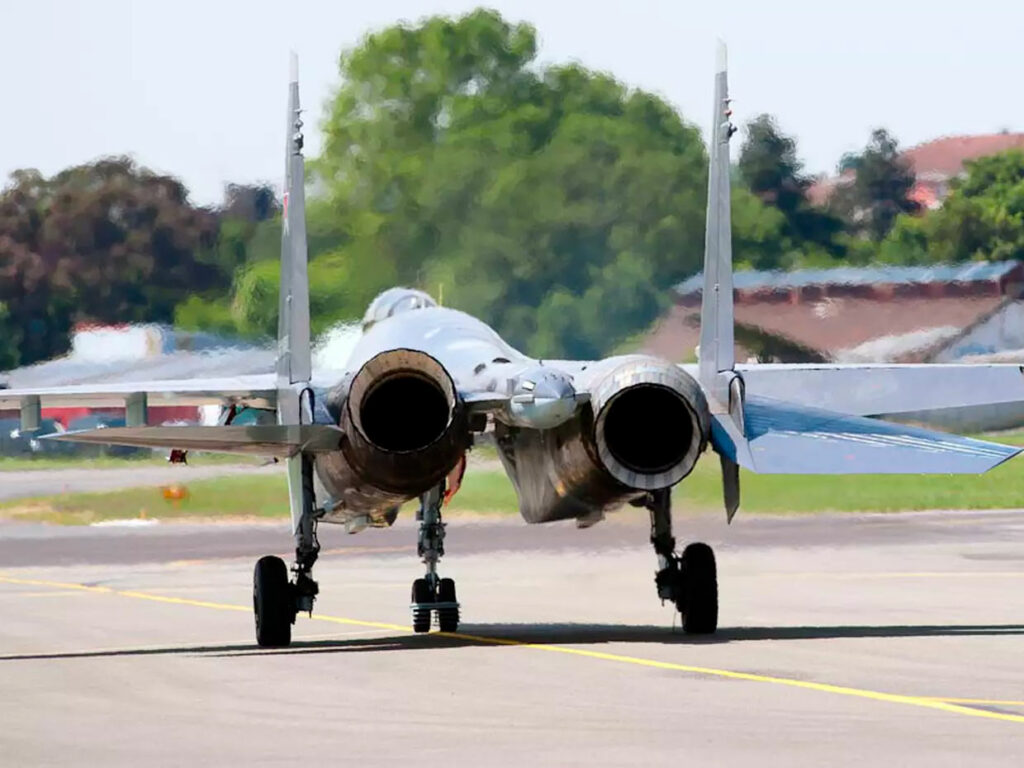
Technical analysis of the three-dimensional thrust vectoring of Russian Su-30SM and Su-35 fighter jets, with data and concrete examples.
Three-dimensional (3D) thrust vectoring is a significant advance in Russian fighter jet design, particularly in the Su-30SM and Su-35. This technology provides exceptional maneuverability, offering tactical advantages in close combat. This article examines in detail how this technology works on the Su-30SM and Su-35, highlighting the technical aspects and associated performance.
3D thrust vectoring on the Su-30SM
The Su-30SM, developed by Sukhoi, is equipped with two AL-31FP engines with 3D thrust vectoring nozzles. These nozzles can deflect the exhaust gas flow in the vertical and horizontal planes, providing increased maneuverability.
Each AL-31FP engine provides a maximum thrust of 12,500 kgf with afterburner. The nozzles can be oriented up to ±15 degrees vertically and ±8 degrees horizontally, enabling maneuvers such as the “Pugachev’s Cobra” and the “Tailslide.” These capabilities are particularly useful in close air combat, where the ability to change direction quickly can be decisive.
The Su-30SM’s flight control system integrates thrust vectoring into its calculations, ensuring optimal coordination between traditional flight controls and nozzle deflection. This integration allows the pilot to take full advantage of the capabilities offered by thrust vectoring without excessive cognitive overload.
However, this technology presents challenges, particularly in terms of maintenance and mechanical complexity. Thrust vectoring systems require rigorous monitoring and maintenance to ensure proper operation, which can increase operating costs.

3D thrust vectoring on the Su-35
The Su-35, an evolution of the Su-27, is equipped with AL-41F1S engines with 3D thrust vectoring nozzles. These nozzles can deflect the exhaust gas flow in the vertical and horizontal planes, providing exceptional maneuverability.
Each AL-41F1S engine provides a maximum thrust of 14,500 kgf with afterburner. The nozzles can be oriented up to ±20 degrees vertically and ±15 degrees horizontally, allowing complex maneuvers at low speeds and high angles of attack. These capabilities are particularly useful during air demonstrations and close-range air combat.
The Su-35 incorporates a digital flight control system that coordinates traditional flight controls with nozzle deflection. This integration allows for quick and precise response to pilot commands, improving the aircraft’s maneuverability.
However, as with the Su-30SM, the complexity of the Su-35’s thrust vectoring system requires rigorous maintenance. In addition, intensive use of this technology can lead to increased component wear, requiring more frequent inspections and replacements.
Comparison of the thrust vectoring systems of the Su-30SM and Su-35
The Su-30SM and Su-35 both use 3D vector thrust systems, but there are notable differences.
The Su-30SM is equipped with AL-31FP engines, while the Su-35 uses more powerful AL-41F1S engines. The Su-35’s nozzles offer a greater range of deflection, allowing for more extreme maneuvers. In addition, the Su-35’s flight control system is more advanced, offering greater integration of thrust vectoring.
In terms of performance, the Su-35 benefits from a higher maximum speed and better acceleration thanks to its more powerful engines. However, the Su-30SM, with its two-person crew, offers better task distribution, which can be advantageous during complex missions.
In summary, the Su-35 offers superior performance in terms of thrust vectoring and maneuverability, while the Su-30SM has advantages in mission management and crew coordination.
Thoughts on the operational usefulness of 3D thrust vectoring
3D thrust vectoring offers undeniable advantages in terms of maneuverability, but its operational usefulness is a matter of debate.
In modern air combat scenarios, long-range engagements are preferred, reducing the importance of close-range combat where thrust vectoring excels. In addition, the complexity and maintenance costs of thrust vectoring systems may limit their widespread deployment.
However, in specific situations, such as air demonstrations, close combat, or missions requiring extreme maneuverability, 3D thrust vectoring can offer a significant tactical advantage. It enables maneuvers that are impossible for aircraft without this technology, providing superior positioning and reaction capabilities.


3D thrust vectoring represents a major technological advance
Three-dimensional thrust vectoring was developed to overcome the classic aerodynamic limitations of Russian high-angle-of-attack fighter aircraft. On aircraft such as the Su-30SM and Su-35, it literally transforms flight behavior. Unlike conventional aircraft, which use only moving surfaces (control surfaces, ailerons), the Su-30SM and Su-35 modify the direction of the engine thrust itself, providing additional control independent of the airflow over the wing surfaces. This remains a critical factor in combat at very low speeds or during controlled stalls.
However, several points should be emphasized without complacency. From a purely operational standpoint, 3D thrust vectoring comes at a cost: it adds weight, reduces overall engine reliability, and increases maintenance times. The average service life of the Su-35’s vector nozzles is estimated at 800 hours, which is about 20% less than that of a conventional non-vector nozzle. This figure is not insignificant for a fleet engaged in repeated missions in real theater of operations.
The United States has deliberately chosen not to integrate similar systems on most of its recent aircraft, including the F-35A, preferring to focus on stealth, sensor fusion, and long-range weapons. The Russian approach, embodied in the Su-35, favors maneuverability-based air superiority. This is a clear doctrinal gamble. It reflects a concept of air combat still largely influenced by dogfight superiority, which continues to be taught in Russian fighter schools.
It should also be noted that the intensive use of thrust vectoring in dusty or sandy environments, such as in Syria or Africa, accelerates engine degradation. The cost of replacing an AL-41F1S engine is around $5 million, which imposes budgetary constraints on the Russian air force, already hampered by post-embargo financial restrictions.
In terms of raw performance, the Su-35 and Su-30SM have demonstrated clear maneuverability superiority over previous-generation Western aircraft in joint exercises (such as “Aviadarts” and “Tsentr”). During these exercises, the Su-35 was able to engage targets at attack angles greater than 60° while maintaining dynamic stability and the ability to fire. These capabilities are useful in a limited number of situations but must be interpreted in the broader context of contemporary air warfare, which tends to be fought well before visual contact is made.
A technological choice with industrial and strategic implications
The development and integration of 3D thrust vectoring on the Su-30SM and Su-35 involved specific industrial choices. The OAO “Lyulka-Saturn” design bureau, responsible for the AL-31FP and AL-41F1S engines, had to develop high-temperature articulated nozzles capable of withstanding afterburner temperatures of up to 2,000°C. Each nozzle incorporates redundant electromechanical actuators enabling a rapid response (< 0.2 seconds) to commands from the pilot or the on-board computer.
The Russian industry relies on suppliers specializing in titanium and nickel-based alloys, often produced by entities that were part of the former Soviet military-industrial complex. Western sanctions have complicated access to certain high-quality materials, forcing substitution with domestically manufactured components. This transition has led to production delays, particularly on certain export versions of the Su-30.
From a strategic standpoint, the use of thrust vectoring as a selling point has enabled Russia to capture high-value aerospace markets. Countries such as India, Malaysia, and Algeria have been attracted by these advanced maneuvering capabilities, which are seen as a deterrent and a source of superiority in their regional space. The cost of a Su-30MKI equipped with thrust vectoring is estimated at €55 million in full configuration. The Su-35 exported to China was negotiated at around €78 million per unit.
Vector thrust is therefore not just a technical choice. It is an instrument of doctrine, industrial strategy, and military diplomacy. It reflects a mindset that prioritizes maximum kinematic performance over passive stealth. It is also a bet on the usefulness of close combat in theaters where jamming or electronic warfare systems can render long-range engagements obsolete.
War Wings Daily is an independant magazine.